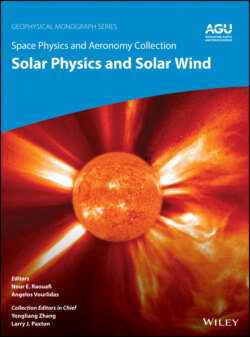Читать книгу Space Physics and Aeronomy, Solar Physics and Solar Wind - Группа авторов - Страница 25
1.5.2. Wave–Particle Interactions, Kinetic Instabilities, and Collisions
ОглавлениеThe low density of the solar wind plasma could lead to the expectation that it could be described as collisionless; that is, Coulomb collisions are negligible. Nevertheless, Coulomb collisions do play a role in constraining temperature anisotropies (Pierrard et al., 2016; Pierrard et al., 2011; C. Salem et al., 2003; Štverák et al., 2008)
Figure 1.17 Kinetic shells formed in the electron VDF by resonant electron–whistler interaction (solid lines), and isolines of an undisturbed Maxwellian VDF (dotted lines). Shown are two plots for different values of the electron Alfvén speed, vA,e = 0.5 c (left, (a)), and vA,e = 0.05 c (right, (b)).
(Source: From Vocks & Mann, 2003. © 2003, IOP Publishing.)
Non‐Maxwellian particle distributions can become unstable toward numerous plasma instabilities (Štverák et al., 2008). Quasi‐linear theory (Kennel & Engelmann, 1966) is a useful tool to study the effect of whistler waves on the evolution of solar wind electron distributions. It considers nonlinear effects between plasma waves and the fluctuations they cause in the plasma, and therefore diffusion terms are included in the Boltzmann–Vlasov equation. Solar wind models including the effects of whistler wave turbulence are capable of reproducing the observed characteristics of solar wind electrons (Pierrard et al., 2011; Vocks, 2012).
While whistler wave turbulence leads to waves propagating in all directions relative to the background magnetic field (Chen et al., 2010; Gary & Smith, 2009), even solar wind models that consider only the interaction between electrons and whistlers propagating parallel to the magnetic field result in electron distributions with a core, halo, and strahl (Vocks et al., 2005).
The quasi‐linear interaction between parallel propagating whistlers and electrons leads to pitch‐angle scattering in the reference frame of the waves, which leads to the formation of “kinetic shells” (Isenberg et al., 2001); see Figure 1.17. In interplanetary space, whistler wave phase speeds are not larger than electron thermal speeds, so there is little difference between the wave frame and the plasma rest frame. So whistler turbulence tends to lead to more pitch‐angle diffusion. The observation of finite strahl widths already implies that some pitch‐angle scattering mechanism must be active in the solar wind, because otherwise the conservation of magnetic momentum in the expanding magnetic field geometry of the solar corona and wind would focus the electrons into an extremely narrow beam.
If the whistler wave phase speed is much higher than electron thermal speeds, as is the case in the solar corona, then the kinetic shell formation not only leads to pitch‐angle diffusion, but also deforms the distribution toward higher temperature anisotropies, T⊥ > T∥. The diffusion process brings electrons from a phase‐space location with low v∥, v⊥ = 0 to a position with high v⊥, v∥ = 0. In the plasma frame, this corresponds to a gain of kinetic energy. Therefore, this mechanism is capable of producing a suprathermal population out of an initially Maxwellian electron distribution (Vocks et al., 2008), thus forming a halo component with a power‐law distribution.
